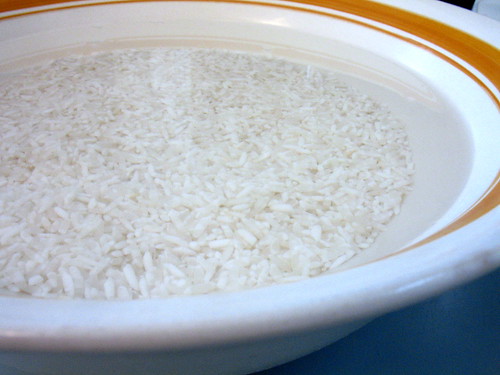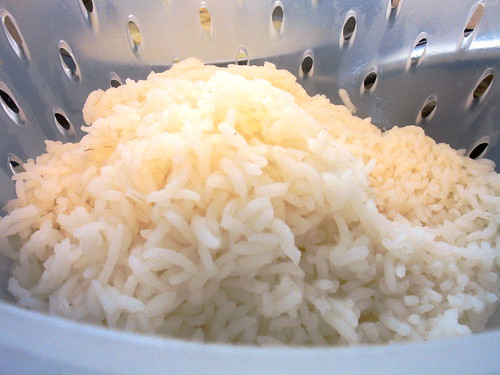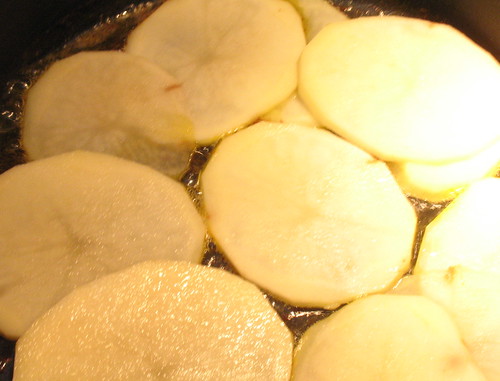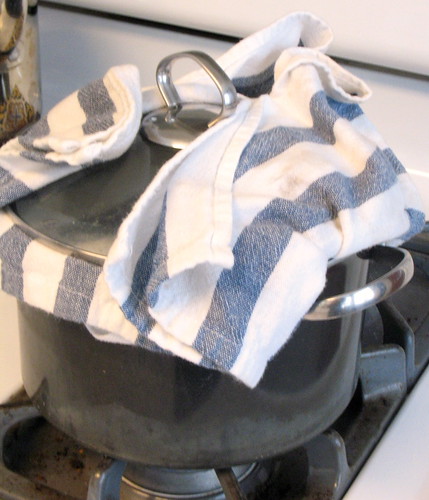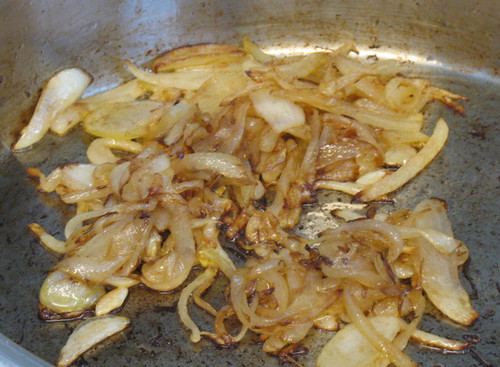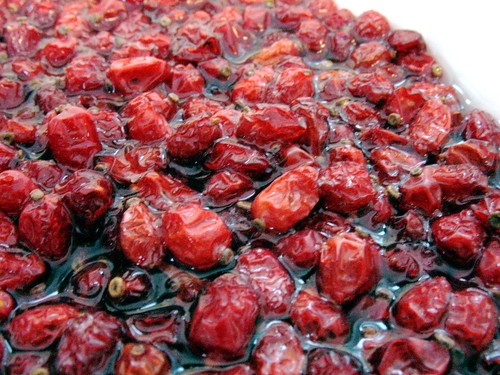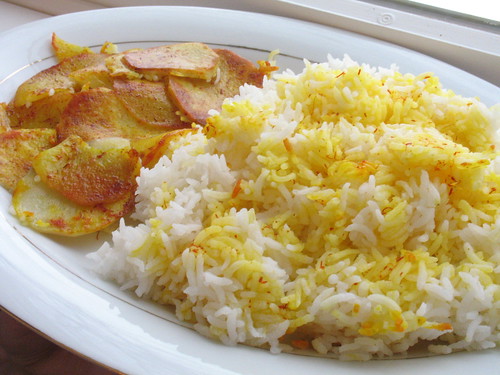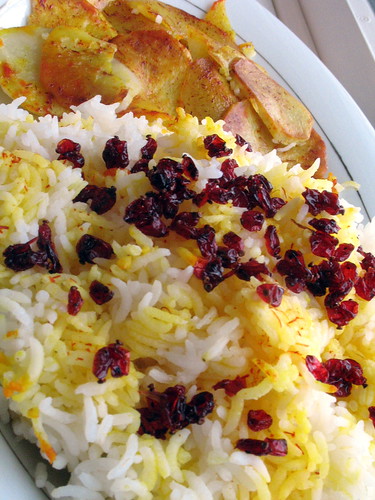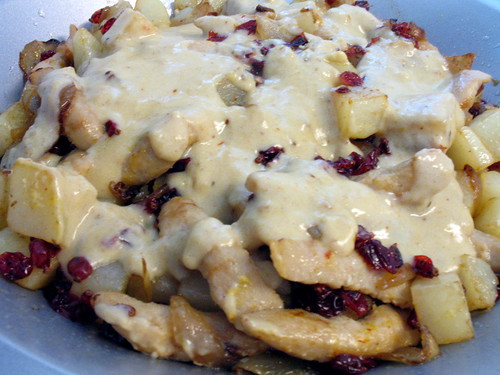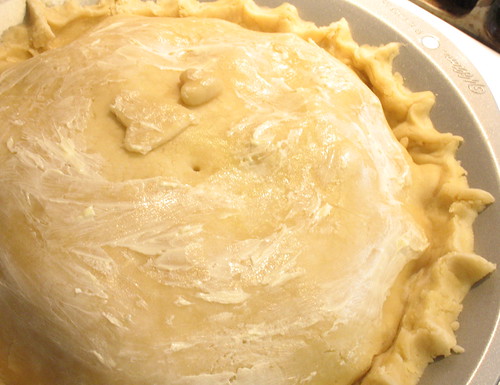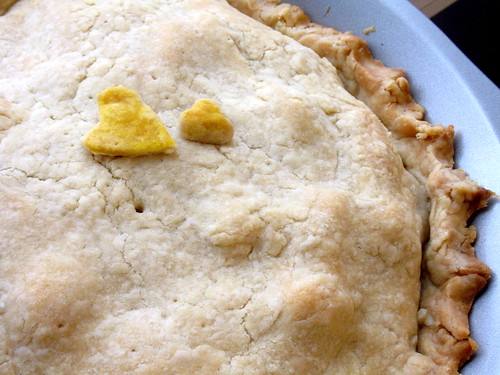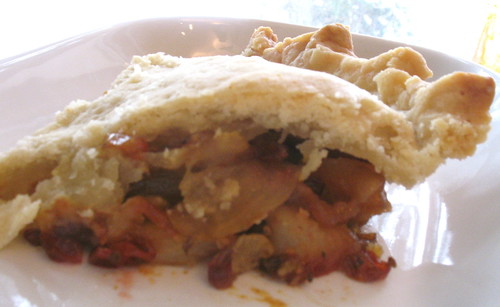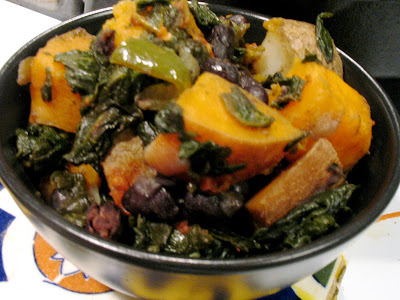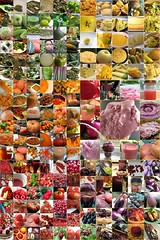I'm so excited to finally bring you my first Iranian cooking tutorial. I've decided it's about time someone set about to veganizing some of the wonderful dishes of this cuisine, and it may as well be me!
In this first installment, I will give you a recipe and step-by-step photos on how to make "zereshk polo ba morgh" a.k.a. "rice pilaf with barberries and chicken" or should I say "chick'n". The reason I chose this dish is because it's an interesting and delicious one, and also touches on three important skills of Iranian cooking: rice, tah-digh (or the crispy rice or potatoes on the bottom of the rice pot), and caramelized onions.
Finally, zereshk polo has been on my mind a lot lately as I've been trying to come up with an entry for this month's "Waiter there's something in my..." food event with the theme of pie. I thought, wouldn't it be crazy to take a traditional Iranian dish and put it in (the decidedly NOT traditional) pie form? My result was the "chik'n zereshk pot pie with saffron cream sauce" which I've saved for the end of this post.
Click here to see what other food bloggers found in their pies this month: Waiter, there's something in my...pie! Hosted by the fabulous blog, Cook Sister!
Ok, on to the recipe.
Zereshk Polo ba Morgh (Rice Pilaf with Barberries and chicken) - vegan edition
Ingredients:
- 1 Cup white basmati rice
- cooking oil of choice, divided
- non-hydrogenated vegan margarine of choice (I used Earth Balance), divided
- 2/3 Cup dried Barberries, reconstituted in warm water
- 1 medium or large white onion
- About 1 cup vegan chicken of choice (I used 1/2 package of Lightlife Chick'n Strip but I imagine tofu, seitan, and tempeh would all be good.)
- 1 medium potato, sliced thinly
- 1 tsp. saffron, divided
- salt and pepper to taste
Instructions:
To cook the rice in true Iranian way, follow these instructions. Iranian-style rice should be light and fluffy with seperate grains.
First, rinse the rice in cold water until the water runs clear. Use this as an opportunity to pick out any debris or discolored rice.
Next, soak the rice in cold water for at least 1/2 hour, like this:
Meanwhile, bring a large pot of salted water to boil. You don't need to measure the water, as you'll later drain the rice. When water has come to a boil, drain soaking liquid from rice and add it to the pot. Let it cook at a gentle boil, uncovered, until "al dente"-i.e. the rice is still a little undone on the inside. Times can vary, but this only took me about 5 minutes, so keep a close eye.
When the rice has reached the "al dente" stage, drain into a colander, like this:
Working quickly, put the pot back over high heat. Add enough oil and margarine to liberally coat the bottom of your pot. Sprinkle some saffron into the oil to give it color and flavor. Next, layer the sliced potato in the oil, like this:
Still working quickly, add the rice back into the pot, making sure it's fairly even. Cover the pot with a paper towel or kitchen towel and then put on the lid. This helps the pot seal tightly, and also soaks up the moisture of the steam, so that it doesn't leech back into the rice. (Remember, fluffy fluffy!) Here's what the closed pot looks like:
If you have a gas stove, be careful not to let the towel hang too low and be a fire hazard! At this point, turn the heat to low and let the rice cook/steam for about 20-25 minutes.
Next, make "piaz dagh". This literally means "hot onion" in Farsi, and it refers to caramelized onions. You have to have great patience to gently cook onions so that they go from this:
To this, without burning:
Caramelizing onions over medium-low heat releases their sugars and transforms their flavor immensely. To the onions, add your "chick'n":
Cook for the proper length of time according to what type of meat substitute you are using. Chick'n strips are not meant to be cooked very long, so I just stirred them briefly with the onions before turning the heat off.
Next, the zereshk. You might have read my previous post where I talked about these funny tangy little berries. You should be able to find them at Iranian supermarkets, or order them on-line. Here they are soaking in warm water:
Drain them of their soaking water, and sautee them with a mixture of oil and margarine and a little splash of saffron for about 5 minutes over medium-high heat, or until they release their aroma. Some Iranian cooks prefer to sautee zereshk with sugar to cut the tang, but I prefer leaving them as is. According to your tastes, you can try this with sugar of course.
Next comes time for assembly!
It is customary to serve the rice and the "tah digh" seperately. Here I have arranged them on the same platter:
You'll notice that for added color, I've sprinkled the top of the rice with a mixture of hot water and saffron. A few spoonfuls of water should suffice, since you don't want soggy rice. (Fluffy, fluffy!)
Next, by adding the barberries to the rice, you've gone from "polo" to "zereshk polo."
Next, by adding the chick'n/onion mixture, you've gone from having "zereshk polo" to having "zereshk polo ba morgh." Ta-da- you're done! Enjoy!
Waiter, there's something in my...pie!
I decided to bring together some of the traditional flavors of my childhood together in the form of the very untraditional pie, to make
"Chick'n Zereshk Pot Pie with Saffron Cream Sauce"
Ingredients:
Crust: (I modified the basic pie crust recipe from James McNair's Favorites) This will make enough for two crusts, but this pie only needs one. You can make two pies, halve the recipe, or use one crust for something entirely different- it's up to you!
- 3 Cups all-purpose flour
- 1 tsp. salt
- 1/2 Cup non-hydrogenated vegetable shortening (I used Spectrum brand)
- 1/2 Cup non-hydrogenated vegan margarien (I used Earth Balance)
- 1 TB. non-dairy sour cream (I used Tofutti)
- up to 1/2 Cup ice water
Mix flour and salt together and pour into a food processor. Incorporate the shortening, the margarine, and the sour cream by adding about one tablespoon at a time and then briefly pulsing your food processor. After all the shortening, margarine and sour cream has been added, transfer the mixture into a large cold bowl. Sprinkle on ice water and gently blend dough until it comes together.
Divide dough into two balls. Put each ball between two sheets of wax paper and roll gently until they are 5-inch discs of dough. At this stage, refrigerate dough for at least 2 hours up to overnight.
When you are ready to use the dough, take one disc out of the refrigerator and allow to come to room temperature (about 10-20 minutes.)
Filling:
- chick'n & caramelized onion mixture from "zereshk polo" recipe, above
- 1 small/medium potato, peeled, cubed, and sauteed
- sauteed zereshk from above recipe
- 2 TB. margarine
- 1 TB. flour
- 1/2 - 3/4 Cup unsweetened soymilk
- dash of saffron
Fill a pie dish with a mixture of the chick'n, caramelized onions, sauteed potatoes, and sauteed zereshk.
To make the sauce, melt margarine over low heat. Add flour gradually. Whisk constantly for about 2-3 minutes until you have a light roux. Gradually add the soymilk and continue to whisk until it has reached sauce consistancy, about 4-5 minutes. Turn off heat. Add a dash of saffron to the sauce. Pour over the mixture in the pie dish, and refrigerate until cool.
To assemble the pie:
Pre-heat oven to 450 degrees.
Roll out thawed pie crust until it is about 2 inches in diameter larger than your pie dish. Gently place the dough over the cooled mixture and crimp the edges shut. Brush the top with more margarine, like this:
Put the pie into the pre-heated oven. After 10 minutes, turn temperature down to 350 degrees, and continue cooking for 20-25 minutes until the crust is a golden brown:
(I couldn't resist putting little saffron-colored heart cut-outs on it!) Let pie cool for at least 10 minutes. Slice and serve. I really liked this pie. The extra-tender crust created the perfect contrast for the rich, fragrant filling. Enjoy!
